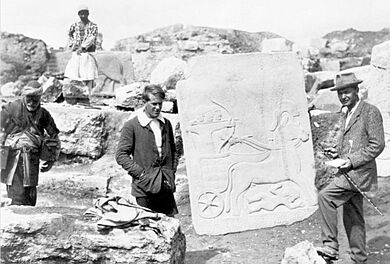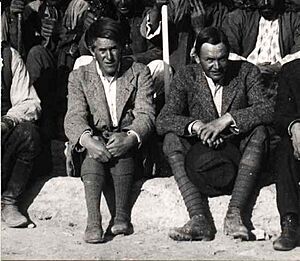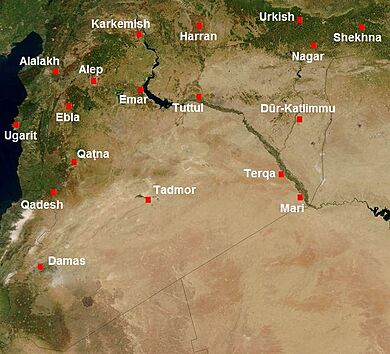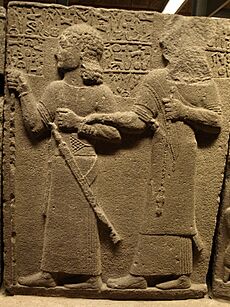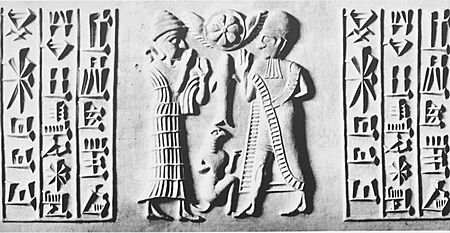Carchemish facts for kids
Quick facts for kids
Viceroyalty of Carchemish / Kingdom of Carchemish
Karkamiša
|
|||||||||||
|---|---|---|---|---|---|---|---|---|---|---|---|
| c. 1321 BC–717 BC | |||||||||||
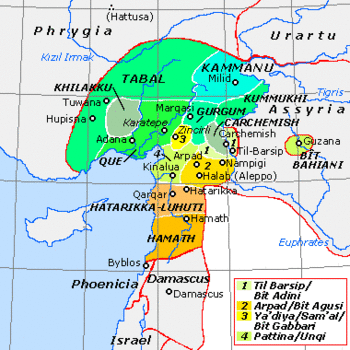
Carchemish among the Neo-Hittite states
|
|||||||||||
| Capital | Carchemish | ||||||||||
| Common languages | Hittite, Hieroglyphic Luwian | ||||||||||
| Religion | Hittite-Luwian religion | ||||||||||
| Government | Monarchy | ||||||||||
| Historical era | Bronze Age, Iron Age | ||||||||||
|
• Established
|
c. 1321 BC | ||||||||||
|
• Disestablished
|
717 BC | ||||||||||
|
|||||||||||
| Today part of | Turkey Syria |
||||||||||
Carchemish (/ˈkɑːrkəmɪʃ/ kar-KƏM-ish or /kɑːrˈkiːmɪʃ/ kar-KEE-mish), also spelled Karkemish (Turkish: Karkamış), was a very important ancient capital city. It was located in the northern part of the Syria region.
During its long history, Carchemish was sometimes an independent city. Other times, it was part of larger empires like the Mitanni, Hittite, and Neo-Assyrian Empires. Today, the ruins of Carchemish are found right on the border between Turkey and Syria.
An important battle happened here around 605 BC. The Babylonians fought against the Egyptians. This battle is even mentioned in the Bible (Jer. 46:2, 2 Chron. 35:20). Nearby modern cities are Karkamış in Turkey and Jarabulus in Syria.
Contents
Exploring Ancient Carchemish
Carchemish is now a large area of ruins. It covers about 90 hectares (that's like 126 football fields!). About 55 hectares are in Turkey, and 35 are in Syria. The site sits on the west bank of the Euphrates River. It is about 60 kilometers (37 miles) southeast of Gaziantep, Turkey. It is also about 100 kilometers (62 miles) northeast of Aleppo, Syria.
The Baghdad Railway crosses the site. This railway now marks the border between Turkey and Syria. The ancient city had an acropolis (a high, fortified part) along the river. It also had an Inner Town with earth walls and an Outer Town. Most of the Outer Town is in Syria. A Turkish military base is on the site. Only the acropolis area has restricted access.
Discovering Carchemish: A Look Back
Scholars have always known about Carchemish. This is because it is mentioned in the Bible, and in ancient Egyptian and Assyrian writings. In 1874, James H. Skene, a British Consul, suggested that these ruins were Carchemish. This was confirmed in 1876 by George Smith.
Between 1911 and 1914, full excavations took place. D. G. Hogarth led these digs. Famous people like T. E. Lawrence (known as "Lawrence of Arabia") and C. L. Woolley worked there. These excavations found many remains from the Assyrian and Neo-Hittite periods. They uncovered defensive walls, temples, and palaces. They also found many basalt statues and carvings with Luwian hieroglyphic writings.
Excavations stopped in 1914 because of World War I. They finally ended in 1920. From 1956 to 1998, the entire site was mined by the Turkish Land Forces. This made it unsafe to visit.
After the mines were cleared in 2011, archaeological work started again. A team from universities in Bologna, Gaziantep, and University of Istanbul began new excavations. They found exciting things, like Katuwa's Palace (around 900 BC). They also found a cuneiform tablet with an ancient prayer. In 2014, they found beautifully carved stones showing people carrying gazelles.
In 2015, more discoveries were made in the palace area. They found many items, including two pieces of clay cylinders. These cylinders had a unique cuneiform text by King Sargon. It told how he captured Carchemish. These items were found in a deep well, sealed in 605 BC.
In 2017, archaeologists started digging on the acropolis. They found a large building from the Late Bronze Age. They also found new Iron Age artworks and many ancient clay tablets. In 2019, they found a huge palace on top of the acropolis from the Late Bronze Age.
Carchemish Today
Today, the archaeological park at Carchemish is open to visitors! It opened on July 13, 2019. You can visit between 9 am and one hour before sunset. Guided tours are offered every two hours for safety reasons.
The part of the Outer Town in Syria is considered an endangered cultural site. This is due to farming and the growth of the nearby town of Jerablus. In 2019, the Jerablus City Council declared the area inside the Iron Age city walls a "protected site." This means no building or other activity is allowed there.
In 2016, the Turkish Army built a security wall near the railway. This wall helps protect the site and the border.
A Brief History of Carchemish
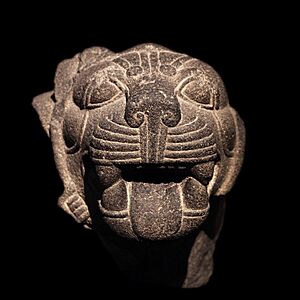
People have lived at Carchemish since the Neolithic and Chalcolithic periods (very early times).
Early Bronze Age
The city is mentioned in ancient documents from Ebla. These documents are from the 3rd millennium BC.
Middle Bronze Age
Around 1800 BC, Carchemish was ruled by King Aplahanda. His son, Yatar-Ami, followed him. Carchemish was an important center for trading timber (wood). It had agreements with other cities like Ugarit and Mitanni.
Carchemish was important because it controlled the main river crossing point on the Euphrates. This made it a very important city for trade and travel.
Later, around 1620 BC, the Hittite king Hattusili I attacked the city of Urshu. Carchemish was allied with the kingdom of Yamhad and tried to help Urshu, but they failed.
Late Bronze Age
The Egyptian Pharaoh Thutmose I put up a stone monument (stele) near Carchemish. This celebrated his victories in Syria.
Under the Mitanni Empire, Carchemish was a strong city. But then, King Šuppiluliuma I of the Hittites captured it around 1345 BC. He made it a kingdom ruled by his son Piyassili. Piyassili's son, Shakhurunuwa, later took part in the famous Battle of Kadesh (1274 BC).
Iron Age
Carchemish became one of the most important cities in the Hittite Empire. This was during the Late Bronze Age. It was strongest around the 13th century BC. Even when the Hittite Empire fell, Carchemish survived. It became the capital of an important Neo-Hittite kingdom in the Iron Age. It remained a busy trading center.
King Kuzi-Teshub ruled Carchemish around 1170 BC. He called himself "Great King." This showed he believed he was the true heir to the Hittite kings. His kingdom was powerful for about 200 years.
Relations with Assyria
In the 9th century BC, King Sangara of Carchemish paid tribute to the Assyrian kings. This meant he had to give them gifts or money to keep peace.
Later, around 717 BC, Carchemish was conquered by Sargon II of Assyria. King Pisiri was the last ruler of Carchemish.
Battle of Carchemish
In the summer of 605 BC, a major battle took place at Carchemish. The Babylonian army, led by Nebuchadnezzar II, fought against the Egyptian army of Pharaoh Necho II. The Egyptians wanted to stop the Babylonians from moving west and control trade routes. But the Babylonians won, and the Egyptians were forced out of Syria.
After this, Carchemish was occupied by the Neo-Babylonians for a short time. Later, there were periods of Persian, Greek, and Roman rule. The city was finally abandoned until the early 1900s.
Kings of Carchemish
| Ruler | Proposed reign (BC) | Notes |
|---|---|---|
| Aplah-anda I | c. 1786 to 1764 | Son of Adni-anda |
| Yatar-Ami | c. 1764 to 1763 | Son of Aplah-anda I |
| Yahdun-Lim | c. 1763 to 1745? | Son of Bin-Ami |
| Piyassili | c. 1315 | Son of the Hittite king Šuppiluliuma I |
| Shakhurunuwa | Son of Piyassilis | |
| Ini-Teshub I | c. 1230s | |
| Talmi-Teshub | c. 1200 | |
| Kuzi-Teshub | c. 1170 | Claimed the title of "Great King" after the fall of Hatti |
| Ini-Teshub II | c. 1100 | |
| Tudhaliya | c. 1100 | |
| Suhi I | c. 975 | |
| Katuwa | c. 900 | |
| Sangara | c. 870–848 | |
| Yariri (regent) | c. 815 | |
| Kamani | c. 790 | |
| Pisiri | c. 730s | The last king, defeated in 717 by Sargon II |
Goddess Kubaba
The main goddess of Carchemish was Kubaba. She was a very important deity. She was shown as a respected woman wearing a long robe. She often held a mirror.
In 2015, a stone monument (stele) of Kubaba was put back together. It was made from six broken pieces found in different museums. This stele was made by King Kamani of Carchemish around 790 BC. The writings on it tell us important things about Carchemish's history.
Kubaba was one of the three main gods worshipped in Carchemish during the Middle Bronze Age. The chief god was Nergal, a god from Mesopotamia. He was also called Il-Karkamis, meaning “God of Karkemish.” Another god was Nubandag, a warrior god.
Later, around the 14th century BC, the main god of Carchemish became Karhuha. He was seen as a Stag-god. The different gods worshipped in Carchemish show how the city was a mix of cultures and religions. This was because it was located at a crossroads of important trade routes.
Ancient Objects from Carchemish
Many interesting objects have been found at Carchemish. Two types of clay figures are very common: the Handmade Syrian Horses and Riders and the Syrian Pillar Figurines.
These are clay statues made between the mid-8th and 7th centuries BC. Hundreds of them have been found in the city. They were made during the Neo-Assyrian time in Carchemish. People believe they might show men and women who held important public roles.
See also
- Cities of the ancient Near East
- Short chronology timeline
- Jerablus Tahtani
- Karkamış
- Carchemish Phoenician inscription


